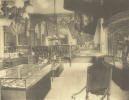
Plate A.
VIEW OF UPPER HALL, LOOKING EAST.
In the foreground is seen a Portuguese chair, the seat and back formed of embossed leather, of the latter part of the seventeenth century, from South Kensington Museum. The coat-of-arms of the Cordwainers’ Company appears on the east wall, and banners belonging to the Company, several of which have been carried in procession on Lord Mayor’s day, are shown. On the north side, facing the orchestra, is a stained glass window ere&ed to the memory of John Came, which was unveiled on the 13th of May, 1896, by the Rt. Hon. Joseph Chamberlain, M.P., Secretary for the Colonies and a member of this Company. The design consists of a central figure of a gentleman clad in the prevailing dress of the period when John Came lived, and is emblematical of a member of the Cordwainers’ Company, being clothed with the livery gown, as befitting one representing a Past Master. The figure is placed in a niche of Italian Renaissance work, and above is introduced the arms of the Company. On the left hand are John Came’s coat-of-arms, and on the right the arms of the Master then in office, Samuel Weymouth Hopwood. Below these are the figures of St. Crispin and St. Crispinian, the patron saints of shoemakers, two Italian Christian brothers who, the story goes, in the times of persecution in the third century under Diocletian and Maximinus, came to Soissons, in France, working as shoemakers for a livelihood. The Roman governor of the town, Rietus Varus, noticing their preaching and prayers ordered them to be executed on the 25th October, A.D. 287, and their bodies thrown on the shore of the river Arona. Warned by an angel, an old man and his sister went and found the bodies, and supernaturally supplied with a boat, carried the martyrs to it, and gave them a decent burial near their cottage. In the lower portion of the window is a frame of richly-wrought work held up by two boys, who point to the picture contained in it and to the good deeds of John Came, namely, the distribution of alms to the blind, deaf and dumb, and widows of clergymen.